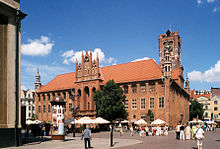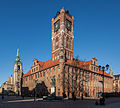Old Town Hall in Thorn
The old town hall in Thorn (Polish: Rynek Staromiejski w Toruniu ) is the most important secular building in Thorner's old town, a Gothic building that was built in stages in the 13th and 14th centuries and rebuilt after being destroyed in the 18th century. It is considered an excellent example of middle-class bourgeois architecture in Central Europe and is the headquarters of the district museum in Thorn. The town hall is located in the old town complex, on the old town market.
history
The original development of the inner ring block took place gradually in the course of the 13th and 14th centuries. The department store accommodating the Cloth Hall ( domus forensis ) was probably built on the site of the current west wing on the basis of a privilege granted in 1259 by Landmeister Prussia Gerhard von Hirzberg. The next privilege to build the tower, market stalls and bread banks on the place of today's east wing of the town hall dates from 1274. According to a reconstruction by E. Gąsiorowski, the development of the Old Town Market at the end of the 13th century consisted of two elongated, parallel buildings. The two-story department store and bread banks were on the west side. The gables of the two buildings were connected by curtains . On the south side, the tower, which was extended by two floors in 1385, was connected to the bread banks and bread stalls and has been preserved in this form to this day.
The current shape of the town hall is mainly due to the construction investment from the years 1391-1399, which was probably managed in Gothic style by the Polish council builder Meyster Andris on the basis of a 1393 privilege granted by Grand Master Konrad von Wallenrode (the privilege was only granted during the construction process). At that time, the old business buildings were torn down, leaving only the tower behind. The administrative, business and judicial tasks were brought together in one building, which was an exceptional solution in Europe at the time. The town hall was a four-wing, rectangular building measuring 44 × 52 m. Its inner courtyard was accessible through four through gates in the middle of each wing. The tower was built according to the Flemish model ( belfry ) and crowned with a high Gothic pointed helmet, which became a characteristic feature of the former city panorama (it was destroyed in 1703).
The mannerist redesign in the years 1602–1605 on the initiative of Mayor Heinrich Stroband and probably based on a design by Anton van Obberghen consisted of adding one floor to the building. The Gothic character of the town hall was not lost, however, because the extended Gothic niches in the pointed arch were closed. During the renovation, on the other hand, the elements known from Gdansk architecture were introduced - suspended corner turrets and Dutch decoration of the gables in the middle of each wing. The renovation of the Thorner town hall is an interesting testimony to the mannerist architect's respect for the Gothic form.
During the siege of the city by the Swedish troops in 1703 , there was a large fire in the town hall, in which almost the entire interior was destroyed. The gables collapsed and the building remained without a roof until 1722. During the reconstruction between 1722 and 1737, the gables were rebuilt and the interior restored. On the west side, a risalit in a late Baroque shape was added to strengthen the wall that was in danger of collapsing. GB Cocchi also carried out a renovation project for the entire town hall in the late Baroque style. In 1869 the baroque risalit was replaced by a neo-Gothic risalit that has survived to this day . Part of the interior was also rebuilt in the 19th century.
From 1957 to 1964 the building underwent extensive renovations and adapted for use as a museum. The most important works included the reinforcement of the walls and vaults, the restoration of the old appearance of the interiors by demolishing the dividing walls from the 19th century. Some medieval architectural elements that were bricked up at a later date were also exposed. At that time, the wooden roof truss from the 18th century was replaced by a roof truss made of steel.
From 2003 to 2005 the tower and all facades (including those from the inner courtyard) were renovated. The colored tracery decoration was reproduced on the four corner turrets , the viewing terrace and the clock were restored. The roof has been renovated and the lighting has been installed.
Characteristic
The Old Town Hall is near the center of the Old Town Market and is slightly offset to the east. It was built on a rectangular floor plan of 44 × 52 m with an inner courtyard. A four-sided, typically Flemish tower (belfry) rises at the confluence of the south and east wings. All wings and the inner courtyard have a cellar. The cellar vaults under the east wing rest on massive stone pillars. The articulation of all facades (including on the courtyard side) is harmonized and consists of high, narrow niches with strongly profiled corners, which are closed in the flattened pointed arch and extend over the entire height of the building. The corners are emphasized by the overhanging eight-sided two-story turrets, on the wing axes there are mansards with modest baroque gables and a mannerist decor remnant.
The so-called “rich stalls” and bread banks were on the ground floor of the east wing, and the cloth halls were in the west wing. In the north-east corner there is a room with the former city scales, in the north wing, east of the transition is the former courtroom. Most of the rooms on the ground floor are vaulted - the bread benches with a ribbed vault , the cloth hall, scales and courtroom with a triangular vault . The outer wings of each wing (both on the market and courtyard side) were occupied by small sales booths built in from the inside, which were originally only open to the outside and had no connection with other rooms on the ground floor. This required the special lighting of the rooms in the middle of the wings (the bread banks, cloth halls and others) - through the windows installed above the roofs of sales booths.
The first floor was intended for representative purposes and was used as a council chamber, a room in which the city council met. The rich decoration from the years 1602–1603, which was destroyed by fire in 1703, consisted of paneling with paintings by the Gdańsk painter Anton Möller and a ceiling painting. The furnishings in the hall could probably be compared to the furnishings in the Red Hall in the town hall in Gdansk. The largest room on this floor, the Great Citizens' Hall, was able to accommodate important city events and was also intended for the entertainment of kings. The meetings of the Prussian Landtag were also held there. In 1645 the conversation between Protestants and Catholics took place there, which became known as the Thorner Religious Discussion . In the northeast corner is the King's Hall, where King Johann Albrecht died on June 17, 1501 . On the floor there are many portals and wooden doors from the reconstruction in the 18th century, which were decorated with inlays (e.g. the door to the council chamber from 1735 with figures of Minerva and Apollon and the door to the royal hall from 1735 1767 with the figure of King Stanisław II August ).
The second floor was added in 1602–1605 and served as an arsenal , but also a library; it burned down in 1703.
Collections
The town hall is now the headquarters of the district museum. Gothic and late Gothic works of art, mainly from Toruń and Silesia (Brieg, Breslau), were collected on the ground floor of the eastern wing. The stained glass from the 14th century from the churches in Thorn and Culm are among the most valuable pieces of the Gothic art collection . The western wing houses the collections of medieval and modern handicrafts, including the wooden gingerbread molds from the 17th and 18th centuries and fragments of stone decorations from the Ordensburg. The first floor serves mainly as a gallery of contemporary and modern painting. The Bürgersaal houses the gallery of Thorner bourgeois portraits from the 16th - 18th centuries (portraits of Nikolaus Kopernikus , Henryk Stroband and the portraits painted by Bartholomäus Strobel ), as well as paintings by well-known Polish painters such as Jan Matejko , Witkacy , Konrad Krzyzanowski , Jacek Malczewski , Julian Falat . Temporary exhibitions are held on the second floor.
Individual evidence
- ↑ E. Gąsiorowski, Ratusz Staromiejski w Toruniu w okresie średniowiecza , Toruń 1971, pp. 27–34, 60
- ^ Ratusz Staromiejski. Retrieved June 27, 2020 (Polish).
literature
- Gąsiorowski E., Ratusz Staromiejski w Toruniu , Toruń: Muzeum Okręgowe, 2004, ISBN 83-87083-78-X , OCLC 69476768 .















